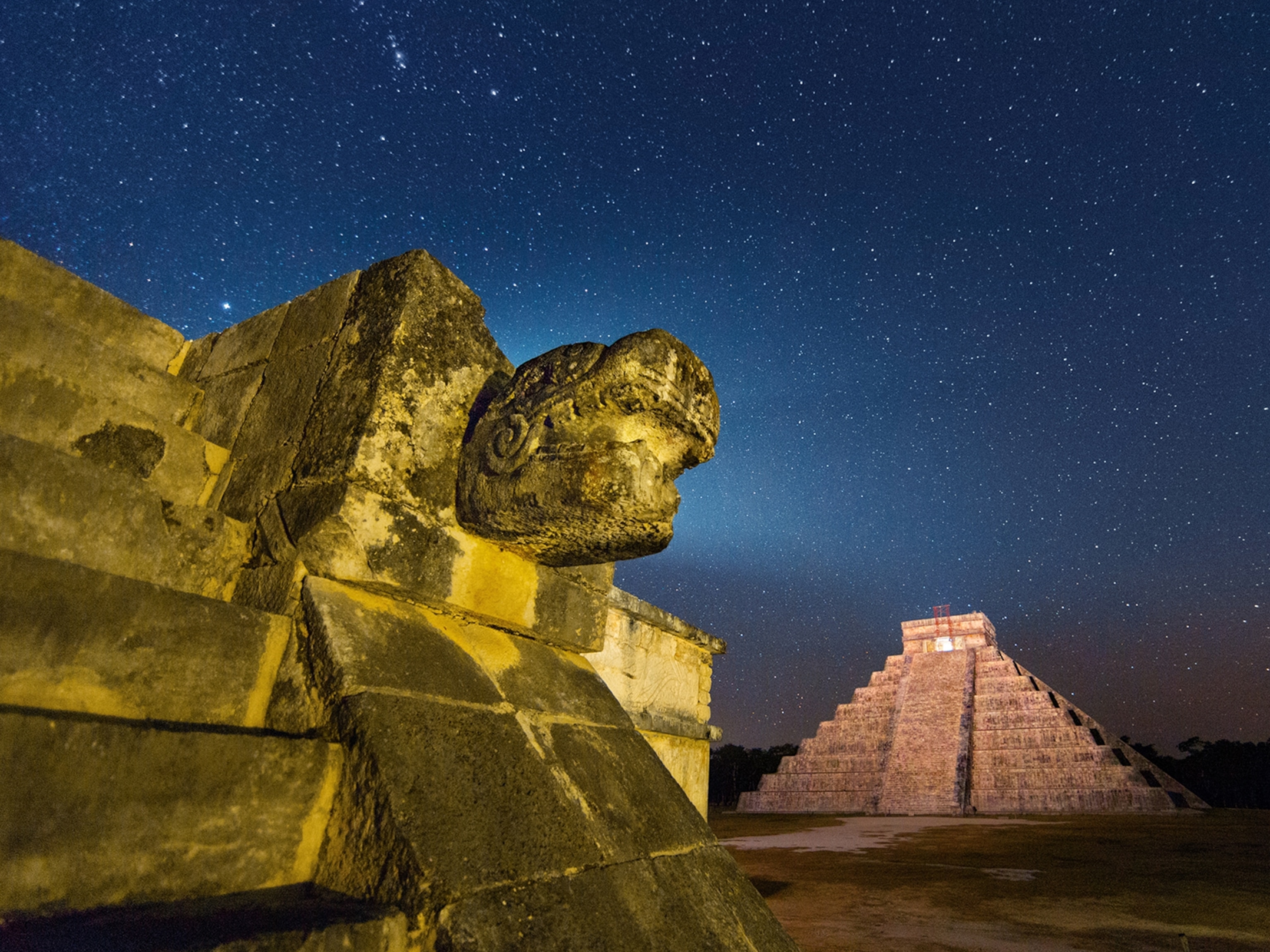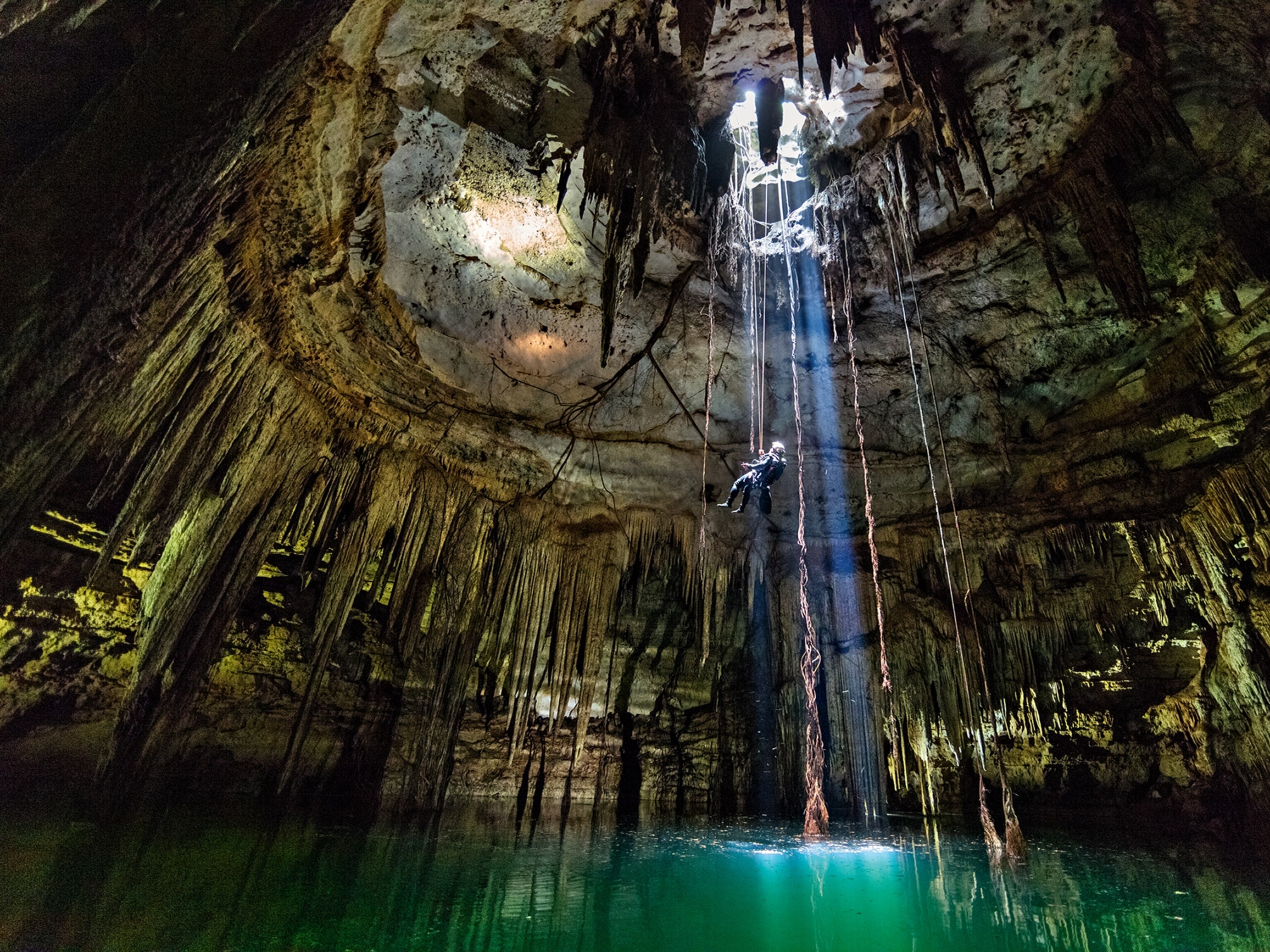
Visit these breathtaking underwater caves in the Yucatán Peninsula
From Maya temples to a makeshift car wash, these four cenotes offer outdoor adventure, fascinating history, and traditional culture.
Though perhaps most known for tourist-packed Cancún, Mexico’s Yucatán Peninsula also holds tens of thousands of beautiful, overlooked cenotes. For the ancient Maya, these natural, freshwater sinkholes had deep spiritual significance. An important water source, they were also a mystical threshold between this world and the underworld, marked with sacrifices of pottery, jewelry, and occasionally human beings. Today, many double as swimming spots popular with locals—and often unknown to tourists. (See the discovery of the world’s largest underwater cave.)
Brimming with history, these four cenotes are worth the trip to take the plunge (or at least a few photos). Explore them while supporting local and indigenous businesses—and, as regional tourism increases, leave no trace on the rich environment.
Cenote Sagrado at Chichén Itzá
Why go: Find the region’s most famous Maya ruins in the archaeological zone Chichén Itzá, a UNESCO World Heritage site. Alongside El Castillo, a 98-foot-tall step pyramid topped by a temple, lies Cenote Sagrado, where archaeologists have found the remains of people who were probably sacrificed to the rain god. Because it’s a sacred site, swimming isn’t allowed, but photography is so pack a camera (and a sun hat). (See amazing pictures of the Yucatán’s Maya-temple-dwelling bats.)
Getting there: Foreigners pay 480 pesos (about $25 USD) to enter Chichén Itzá. Nearby hotels tend to be overpriced, so fly into Mérida or Cancún and stay in charming, historic Valladolid (which also has 15 public cenotes). At Hotel Posada San Juan, beds are accompanied by hammocks so guests can sleep like Yucatecans. Eat like one too: Taste zik’il pak (a light, hummus-like pumpkin seed spread) at Yerbabuena del Sisal.
Tulum’s “Car Wash”
Why go: This 53-foot-deep, 150-foot-wide cenote is so named because taxis drivers used to pull off the road there to—you guessed it—wash their cars. Today, the taxistas have given way to snorkelers and cave divers enjoying this little-touristed swimming hole. Bring your own snorkel gear to spot colorful fish, turtles, and maybe even—from a safe distance—a crocodile. (Read about the search for the lost empire of the Maya.)

Getting there: Fly to Cancún and stay at Tulum’s Mi Amor Hotel to take advantage of their regional excursions, including an archaeologist-led trip to Maya ruins. The Car Wash cenote is a 15-minute taxi ride from the hotel, and costs 50 pesos (about $2.50 USD) to enter. Afterward, follow locals’ example and fuel up on tacos al pastor, aguas frescas, and empanadas at no-frills El Rincón Chiapaneco.
Hacienda Mucuyché
Why go: Want to swim where the Empress of Mexico once did? An 18th-century plantation of henequen (an agave-like plant), Hacienda Mucuyché is home to two cenotes that supposedly hosted Carlota, a Belgian princess who briefly became Empress of Mexico when Napoleon III named her husband emperor. Tour the historic hacienda with a personal guide, then snorkel and float on the canal that connects the two cenotes.
Getting there: Hacienda Mucuyché is a perfect day trip from Mérida, capital of the state of Yucatán and host to its own airport. Stay at Chablé Resort & Spa, a magical old hacienda that makes you feel as though you’re deep in the jungle, then rent a car for the scenic, 45-minute drive to Mucuyché and pay 450 pesos (about $24 USD) to enter. Explore all day before popping into the on-site restaurant for regional cuisine like conchinita pibil, a traditional braised pork dish.
The Seven Cenotes of San Gerónimo
Why go: In the 1500s, fearless warrior Nachi Cocom led the Cocomes Maya people in resistance to the Spanish. According to local legend, he once took refuge from conquistadores in the Seven Cenotes of San Gerónimo, hiding out for several days before emerging to stalk his attackers. He was later forced to surrender, taking the name Juan upon his conversion to Christianity, but his bravery lives on in stories told on tours of the fabled cenotes. (This Maya ritual cave, “untouched” for 1,000 years, stunned archaeologists.)
Getting there: The Seven Cenotes are less than an hour by car from Mérida. Book a daylong guided tour ($119 USD for adults): You’ll bike, snorkel, and learn about Mayan history, with a break for a lunch of poc chuc, a Yucatecan delicacy prepared with grilled meat and citrus.
You May Also Like
Go Further
Animals
- Orangutan seen using plants to heal wound for first timeOrangutan seen using plants to heal wound for first time
- What La Palma's 'lava tubes' tell us about life on other planetsWhat La Palma's 'lava tubes' tell us about life on other planets
- This fungus turns cicadas into zombies who procreate—then dieThis fungus turns cicadas into zombies who procreate—then die
- How can we protect grizzlies from their biggest threat—trains?How can we protect grizzlies from their biggest threat—trains?
Environment
- What La Palma's 'lava tubes' tell us about life on other planetsWhat La Palma's 'lava tubes' tell us about life on other planets
- How fungi form ‘fairy rings’ and inspire superstitionsHow fungi form ‘fairy rings’ and inspire superstitions
- Your favorite foods may not taste the same in the future. Here's why.Your favorite foods may not taste the same in the future. Here's why.
- Are the Great Lakes the key to solving America’s emissions conundrum?Are the Great Lakes the key to solving America’s emissions conundrum?
- The world’s historic sites face climate change. Can Petra lead the way?The world’s historic sites face climate change. Can Petra lead the way?
History & Culture
- A short history of the Met Gala and its iconic looksA short history of the Met Gala and its iconic looks
- Meet the ruthless king who unified the Kingdom of Hawai'iMeet the ruthless king who unified the Kingdom of Hawai'i
- Hawaii's Lei Day is about so much more than flowersHawaii's Lei Day is about so much more than flowers
- When treasure hunters find artifacts, who gets to keep them?When treasure hunters find artifacts, who gets to keep them?
Science
- Why ovaries are so crucial to women’s health and longevityWhy ovaries are so crucial to women’s health and longevity
- Orangutan seen using plants to heal wound for first timeOrangutan seen using plants to heal wound for first time
Travel
- Why this unlikely UK destination should be on your radarWhy this unlikely UK destination should be on your radar
- A slow journey around the islands of southern VietnamA slow journey around the islands of southern Vietnam
- Is it possible to climb Mount Everest responsibly?Is it possible to climb Mount Everest responsibly?




















